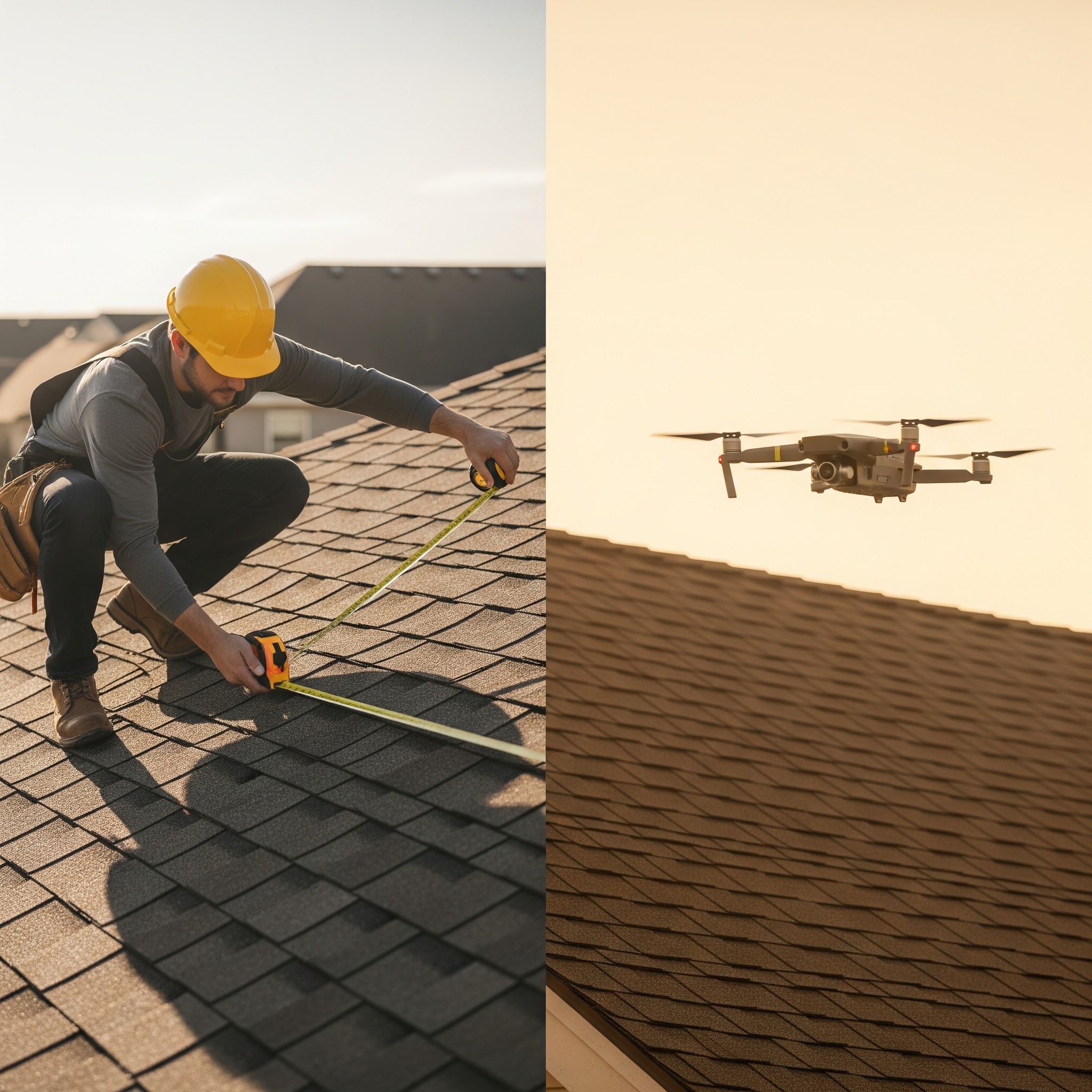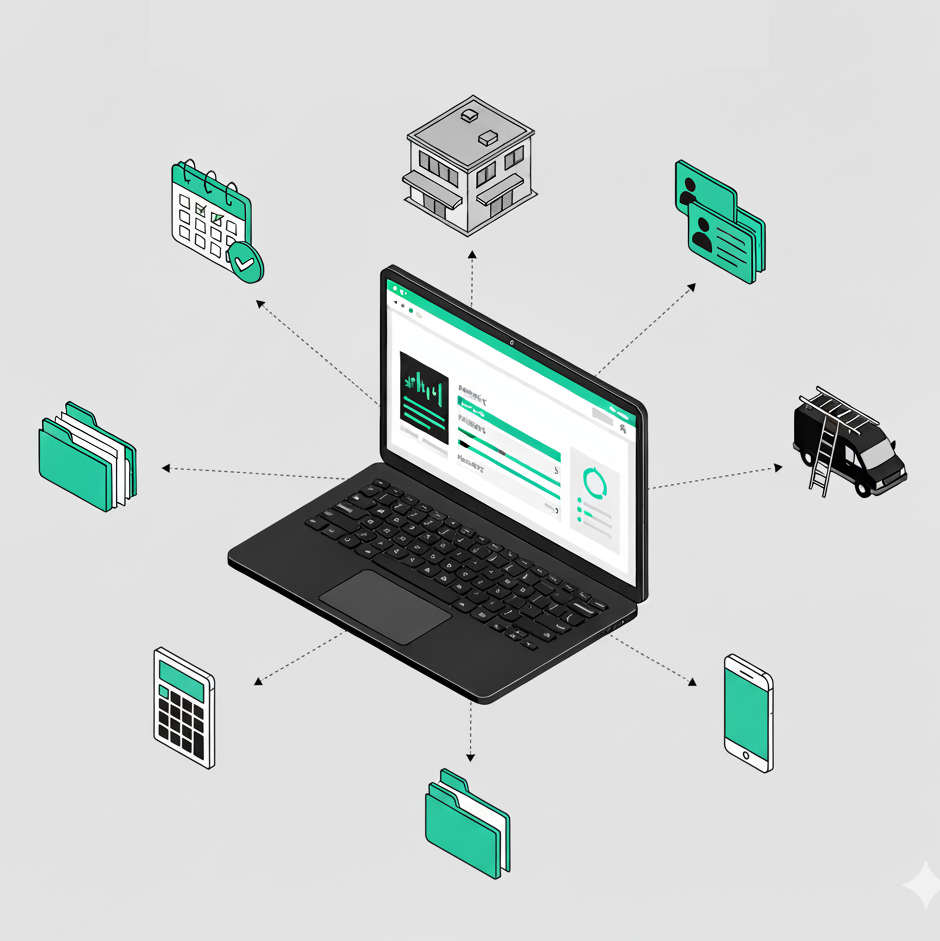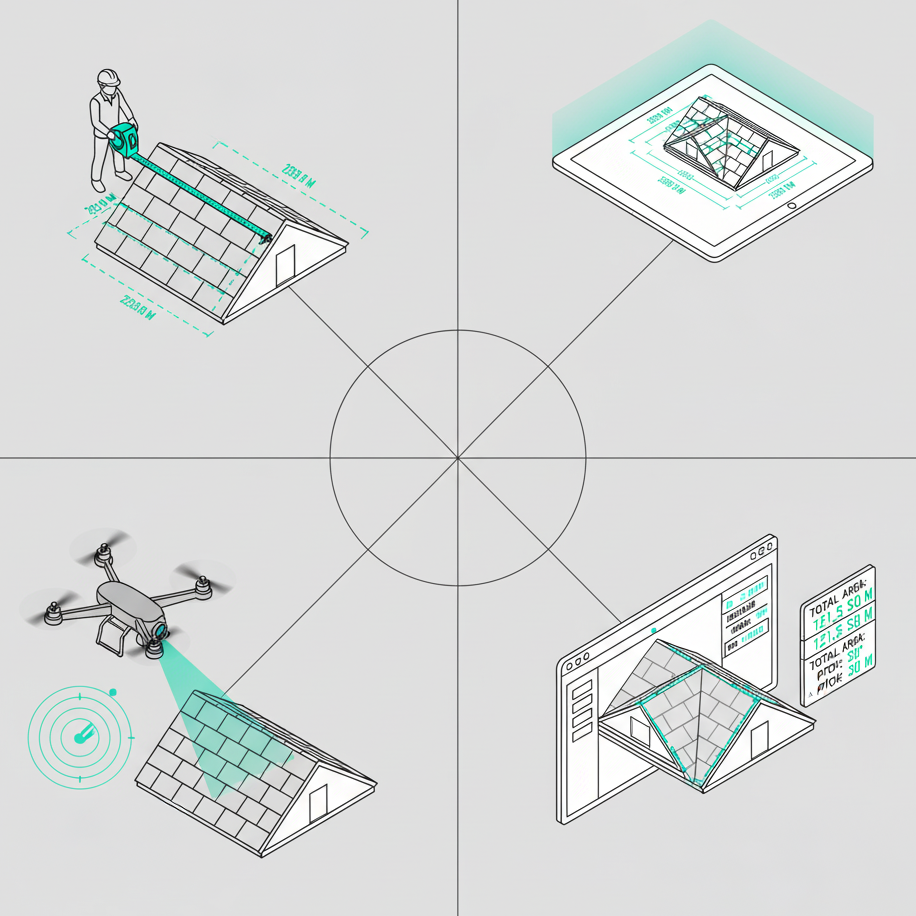Drone measurement vs. manual roof measurement: The comprehensive comparison for roofers 2025


Are you faced with the decision whether you should stick with proven manual measurement methods or switch to modern drone technology? This question is of concern to many roofers, carpenters and solar installers today. The digitization of crafts is progressing, and drone surveying promises significant advantages over traditional methods.
In this comprehensive comparison, you will learn everything you need to know about both measurement approaches. We look at accuracy, time, security issues, and costs — so you can make an informed decision for your business.
Traditional manual roof measurement: Proven methods and their limits
Manual roof measurement has been the standard in crafts for decades. You climb onto the roof with a tape measure, a spirit level and a calculator and measure every meter by hand. This method requires manual skill, experience and a good dose of courage.
Typical tools and equipment:
- Measuring tape and ruler for length and width measurements
- Spirit level and angle meter for inclinations
- Pocket calculator for area calculations on site
- Safety equipment such as helmet, safety belt, and slip-resistant shoes
- Notepad or smartphone for recording
According to Pix4D, planning and data collection can take an entire day. For complex roofs with many dormers and installations, the measurement is extended accordingly. An experienced roofer Georg Hartwich from Dachdeckerei Mann reports on projects with over 6,000 m² and more than 100 dormers: “The manual preparation of the measurements would have kept us busy for weeks.”
Safety risks associated with manual measurement
Climbing on roofs and working with ladders pose significant risks. Studies show that fatal accidents at work regularly occur on construction sites in Germany. According to the World Socialist Web Site, a worker dies on average every four to five days on a German construction site. Roofers are particularly affected: According to CDC-NIOSH data, they accounted for the largest proportion of fatal falls in the construction industry between 2011 and 2017, with 874 of 2,013 cases (43%).
The most common risk factors:
- Dependence on weather: Rain, frost or wind make measurements impossible
- Risk of falling when climbing steep or slippery roofs
- Time pressure leads to careless behavior
- Inadequate safety equipment for “rapid” measurements
The insurance requirements are correspondingly strict. For roof access, you need comprehensive liability insurance and must comply with strict occupational safety regulations.
Accuracy and sources of human error
Manual measurements typically have inaccuracies that can lead to costly errors when ordering and calculating materials.
Common sources of error:
- Reading inaccuracies on the tape measure, particularly when there is wind
- Calculation errors with complex roof geometries
- Transfer error between notes and office
- Forgotten or incorrectly recorded details such as chimneys or dormers
According to Airteam, an inaccurate roof measurement quickly leads to additional costs, incorrect material orders or dangerous miscalculations in the event of snow and wind loads. Roofing company Harnack reports on expensive reorders and recalculations before the introduction of digital measurement.
Drone surveying: The digital revolution for the roofing trade
Drone measurement is revolutionizing traditional roof measurement through the use of photogrammetry and artificial intelligence. According to Airteam, a drone typically captures the entire roof from the air in just a few minutes. Special software then automatically generates precise 3D models and planning data.
The digital workflow in three steps:
- Drone flight: A drone systematically photographs the building from different angles
- AI processing: Photogrammetry software creates a 3D model accurate to the centimeter from the images
- Automatic evaluation: AI recognizes and classifies all roof elements such as dormers, chimneys and throats
The technology uses advanced algorithms for surface recognition and semantic interpretation of roof elements. Not only are the geometries recorded, but relevant components are also automatically classified and measured.
DIN-compliant accuracy through drone technology
According to Airteam, modern drone measurement achieves an accuracy of up to 99.9% with a tolerance of just 1-3 cm over 40 meters. This precision meets the requirements of DIN SPEC 5452-5 and is therefore significantly more precise than satellite data.
Technical specifications:
- Horizontal accuracy: up to 1 cm with professional photogrammetry
- Vertical accuracy: typically half to a third of horizontal accuracy
- RTK workflows achieve accuracies of around 3 cm with ground control points
- DIN SPEC 5452-5 compliance for standardized, comparable results
DIN SPEC 5452-5 defines requirements for a standardized procedure for roof measurement by drone. It sets standards for data formats, accuracies, and processes so that roofers, carpenters, solar installers and other stakeholders can rely on consistent and comparable results.
Saving time and increasing efficiency
According to Airteam, drone measurement saves up to 90% of measurement time compared to manual methods. What used to take hours or even days can be done by the drone in just a few minutes.
Practical examples from craft businesses:
- Dachdeckerei Mann GmbH: Reduction of measurement time from several hours to 20 minutes for complex projects
- Typical time savings: A few minutes of drone flight vs. 2-4 hours of manual measurement
- Productivity increase: More projects per day due to reduced travel and measurement times
You can invest the saved time directly in additional projects or a more thorough offer processing. Many companies report significantly higher product quality due to precise digital data.
Direct comparison: manual vs. drone in practice
This comparison table shows the most important differences between manual and drone measurement in practical use:
Real application scenarios
When manual measurement still makes sense:
- Very small, simple roofs under 50 m²
- Individual repairs or detailed measurements
- Roofs in no-fly zones (very rare)
- Immediate on-site decisions without a planning process
When drone measurement is clearly superior:
- Complex roofs with dormers, bay windows and built-in components
- Solar system planning with precise shading analyses
- Roofs over 100 m²
- Projects with multiple participants and data exchange
- Safety-critical or hard-to-reach roofs
Cost analysis: What pays off in the long term?
According to Airteam, the investment in drone measurement pays off after just 3-6 months for most craft businesses. The calculation is simple: saved time means more projects and higher sales.
Investment costs and current expenditure
Airteam starter packages:
- Fast Fusion: from 125€/month flat rate
- Per merger: higher monthly costs for larger companies
- Starter kits: complete solutions including drone and training
Comparing traditional costs:
- Drone inspections: 80-150€ per flight hour
- Traditional methods: 75-200€ per inspection
- Craftsman hourly rate: around 45-65€/hour
ROI calculation for German craft businesses
Example calculation for a medium-sized company:
With 20 roofs per month and an average time saving of 2.5 hours per roof (from 3 to 0.5 hours), there are significant savings at an hourly rate of 55€. The monthly time saved of 50 hours corresponds to a value of 2,750€. After deducting Airteam costs of 125€/month, 2,625€ net saved costs per month remain.
According to Airteam, the average payback period is 3-6 months. After that, every time saved is pure profit.
Hidden costs of manual measurement
Cost factors that are often overlooked:
- Rework due to measurement errors and material scrapping
- Insurance premiums for roof work and fall risks
- Downtime in case of bad weather
- Liability risks in case of measurement inaccuracies
- Time required for manual data transfer and preparation
Roofing company Harnack reports 100% accuracy and zero rework since the introduction of Airteam. Erroneous material orders and costly recalculations are a thing of the past.
Software integration and workflows
A key advantage of drone measurement is seamless integration into existing planning software. According to Airteam, the data is delivered in various formats that are compatible with popular industry tools.
Supported export formats and integrations
Important software integrations for tradesmen:
- MF roof: JSON file with classified 3D geometries for automatic quotation generation
- PV*SOL and Eturnity: Direct transfer for solar system planning
- SEMA: Export for carpentry companies and timber structures
- Scaffmax: Façade data for scaffolders
- AutoCAD and SketchUp: Standard CAD formats for architects and planners
Optimized workflows
Traditional workflow:
Appointment on site → Climb the roof → Trade Fairs → Notes → Office → Type in → Software → Offer
Digital workflow with drone:
Short drone flight → Upload → Automatic processing → Export to software → Offer
The workflow improvements go far beyond simply saving time. By integrating Airteam, Svea Solar was able to almost halve the planning time for solar systems and at the same time increase the energy yield of the planned systems by 15% while reducing project costs by 25%.
Why Airteam is the ideal solution for craft businesses
More than 5,000 companies already rely on Airteam and have successfully completed more than 70,000 projects. This impressive reference base shows that Airteam is not only superior in theory, but has also proven itself in practice.
Specially developed for the German market
Decisive advantages for German craftsmen:
- DIN compliance: All measurements comply with German standards and norms
- Local Support: German-language customer service and technical support
- Proven integrations: Direct interfaces to established German industry software
- Legal certainty: Support with drone law and approval processes
Success stories from the German craft sector
Dachdeckerei Harnack: Since the introduction of Airteam, the company has achieved 100% accuracy with zero rework. “Every offer fits the first time,” says the management.
Svea Solar: With Airteam, the company was able to reduce planning time by 48%, increase energy yield by 15% and reduce project costs by 25%.
Dachdeckerei Mann GmbH: For projects with over 6,000 m² and more than 100 dormers, the company saved considerable measurement time and was able to acquire more orders.
Safety improvements through drone technology
According to Airteam, since switching to drone measurement, none of the more than 5,000 customers has had an accident at work while measuring the roof. This not only reduces accident risks, but also insurance premiums.
FAQ: Common questions about drone measurement
How accurate are drone surveys compared to manual measurements?
According to Airteam, drone surveys achieve up to 99.9% accuracy with a tolerance of just 1-3 cm over 40 meters. The drone technology meets DIN SPEC standards and provides consistent, verifiable results without human measurement errors.
What time savings are realistic when switching to drone surveying?
According to Airteam, craft businesses save up to 90% of their survey time through digital drone measurement. A typical roof is measured in just a few minutes instead of several hours with manual measurement, as the example from Dachdeckerei Mann GmbH shows.
Is drone surveying also economical for small craft businesses?
With monthly flat rates starting at 125€, the technology is also available to smaller companies. The time savings and increased project capacity typically amortize the investment within 3-6 months.
What are the legal requirements for commercial drone flights in Germany?
Commercial drone flights require appropriate insurance and permits. For most projects, an owner's permit is sufficient for the flight. According to Airteam, since switching to drone measurement, none of the more than 5,000 customers had an accident at work while measuring the roof.
How does integration into existing planning software work?
Airteam offers various export formats for common industry software such as MF Dach, PV*SOL, SEMA and Scaffmax. The seamless integration eliminates manual transfer errors and significantly speeds up the planning process.
conclusion
Drone measurement is no longer just an interesting technology of the future — it is now the economically viable alternative to manual roof measurement. With significant time savings, DIN-compliant accuracy and proven integrations, Airteam offers German craft businesses the opportunity to dramatically increase their efficiency while improving occupational safety.
sources
- Pix4D — Accurately measure your rooftops with drones. https://www.pix4d.com/industry/roofing
- Airteam — Revolution in roof construction. https://www.airteam.ai/en/success-stories/dachdeckerei-mann
- World Socialist Web Site — Fatal Accidents at Work in Germany (2024). https://www.wsws.org/en/articles/2024/07/12/gblh-j12.html
- CDC NIOSH Science Blog — Falls Campaign 2022. https://blogs.cdc.gov/niosh-science-blog/2022/04/13/falls-campaign-2022/
- Airteam — Calculate roof area. https://www.airteam.ai/en/blog/calculate-roof-area-how-to-do-it-correctly-including-formulas-standards-professional-tips
- Airteam — roof measurement with drones. https://www.airteam.ai/en/blog/ratgeber-dachaufmass-drohnen-vermessung
- Airteam — Using Drone & AI to Measure 3D Buildings. https://www.airteam.ai/en
- Airteam — Drone Survey vs. Laser Scan Comparison 2025. https://www.airteam.ai/en/blog/drohnenvermessung-vs-laserscan-dachaufmass
- DIN Media — DIN SPEC 5452-5. https://www.dinmedia.de/de/technische-regel/din-spec-5452-5/345202478
- Airteam — Standardised, precise, future-proof. https://www.airteam.ai/en/blog/standardisiert-prazise-zukunftssicher---airteam-bringt-din-konformes-aufmass-in-die-luft
- Airteam — The ultimate guide - 21 planning formats. https://www.airteam.ai/en/blog/the-ultimate-guide-these-15-planning-formats-are-provided-by-airteam-ai



